- Home
- Injections
- Laser Treatments
- Specialties
Specialtiesview all
- Other Treatments
- Before After Photos
Before After Photosview all
- Contact Us
- Doctor And Staff
- About Celibre
- Blogs
Tired of seeing those little red and purple lines on your cheeks, nose or legs? There’s never been a better time to consider vascular laser treatment to get rid of your unwanted spider veins. Treatment with class IV medical lasers is effective for this problem and has no downtime. Your treatment sessions are quick, easy and your results are instantly noticeable.
Vascular lasers work by targeting hemoglobin, the oxygen-carrying component of red blood cells. They use light energy that is specifically absorbed by hemoglobin and converted into heat energy. This heats up the blood and the vessel walls containing it. The laser energy collapses the blood vessel eliminating it’s appearance at the surface of the skin. Over time, your body breaks down the treated vessels and clears them away naturally. Because spider veins are small, dilated blood vessels on the surface of the skin, removing them is harmless to your circulatory system.
At Celibre Medical, we recommend vascular laser treatments for spider veins be spaced six weeks apart. Though you often see drastic improvement after just a single treatment, more than one treatment may be necessary to obtain best results. We have an array of vascular lasers that are safe to use on any skin type (color) and our laser practitioners are experts at providing safe and effective vein removal treatments.
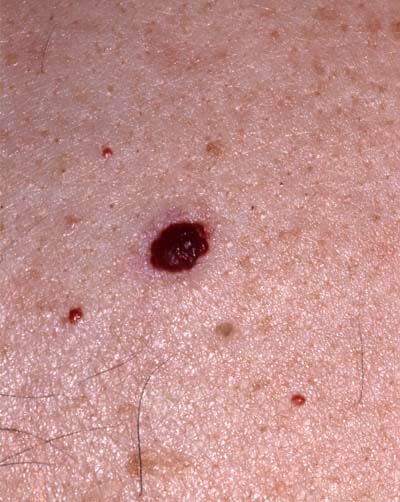 Cherry or spider hemangiomas are also referred to as “blood freckles.” They are benign vascular lesions (blood vessels) that usually begin to appear on the trunk (torso) of the body and then spread to the extremities. Although not usually a cause for health concern, they usually represent a cosmetic concern to patients.
Cherry or spider hemangiomas are also referred to as “blood freckles.” They are benign vascular lesions (blood vessels) that usually begin to appear on the trunk (torso) of the body and then spread to the extremities. Although not usually a cause for health concern, they usually represent a cosmetic concern to patients.
Spider hemangiomas are effectively treated with several types of medical lasers, and cherry hemangiomas are usually resolved with 1 to 2 laser treatments. Some of the larger blood vessels may only shrink in size after 1 or 2 laser treatments and will require additional treatments to completely resolve them. In any event, most patients are pleased to see dramatic improvement with each and every treatment. There is no downtime involved for treatment of cherry hemangiomas and treatments are spaced four to six weeks apart.
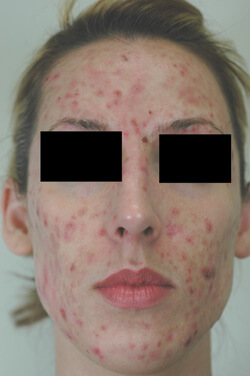
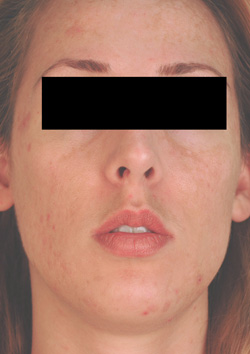 How many acne laser treatments are required is a difficult question to answer because there are many factors involved. Much of the answer depends on the type of acne, severity of the acne, degree of the acne scarring, skin type, and whether or not the patient is able and willing to have downtime. For example, if a patient has moderate inflammatory acne papules without scarring – the treatment plan may consist of 6 acne laser treatments. On the other hand, if the patient comes in with papules lots of whiteheads and cystic acne combined with red, brown or textured acne scarring, the recommended treatment plan may consist of 6 to 9 treatments spaced between 2 and 4 weeks apart.
How many acne laser treatments are required is a difficult question to answer because there are many factors involved. Much of the answer depends on the type of acne, severity of the acne, degree of the acne scarring, skin type, and whether or not the patient is able and willing to have downtime. For example, if a patient has moderate inflammatory acne papules without scarring – the treatment plan may consist of 6 acne laser treatments. On the other hand, if the patient comes in with papules lots of whiteheads and cystic acne combined with red, brown or textured acne scarring, the recommended treatment plan may consist of 6 to 9 treatments spaced between 2 and 4 weeks apart.
We believe that a good acne practitioner will tailor the treatment plan to the patient’s acne condition, goals, skin type, lifestyle, and budget. From there, setting realistic expectations for our acne patients and involving them in the treatment plan is a good starting point. Acne treatment plans should be individualized and open to modification as needed.
Since 2004, we’ve met many patients from Long Beach, CA, and from surrounding areas, who come to us to discuss laser tattoo removal because they’ve been swindled with other tattoo removal gimmicks. There are two in particular that we hear all the time, so we thought we’d set the record straight on these for you here.
First, let us say that as tattoos have become more popular, more and more removal gimmicks have come out targeting those who just don’t want their tattoo anymore. And trust us, we get it. When you’re over a tattoo, you want it gone and you don’t want to spend a lot to get rid of it. If this sounds familiar, then this page is for you. Understanding what’s effective and what isn’t in terms of tattoo removal will ultimately save you two of your most precious resources: your time and money.
The first of these two gimmicks is called “Wrecking Balm”. It is a two-step, mail order system that claims to be a safe and effective alternative to laser tattoo removal. It is based on hydroquinone, a “bleaching” agent for the skin combined with a microdermabrasion-like mechanism. You need to understand that hydroquinone is a medication that slows down the production of melanin, the skin’s natural pigment, which gives it color. Hydroquinone cannot “remove” tattoo ink. It has no ability to “break-up” ink particles and cannot even penetrate the skin to the level where the tattoo ink is. The same is true for the “microdermabrasion”. While this may exfoliate the top few cell layers, there is no capability of this product reaching the deeper epidermis and dermis where tattoo ink is deposited. In short, “Wrecking Balm” is at best misrepresenting it’s capability to remove tattoos, and at worst, flat-out fraudulent claiming it can permanently remove tattoos.
Another treatment that you may have heard of is TCA peeling for tattoo removal. TCA stands for trichloroacetic acid, a powerful chemical skin-peeling agent. While TCA peeling can be very useful for numerous skin conditions, unwanted tattoos are not one of them. Because TCA exfoliates only the outermost layers of skin, it is simply incapable of reaching the levels of the epidermis and dermis where the tattoo ink is.
Also, aggressive TCA peels can produce unwanted side effects such as darkening or lightening of the skin (hyperpigmentation or hypopigmentation) and scarring if not used properly or by inexperienced hands.
Again, we understand that you want your tattoo gone and you don’t want to spend a fortune. But by taking your time, educating yourself and doing your homework, we think you’ll find that laser tattoo removal is the safest, most cost effective option to get rid of your tattoo once and for all. We urge you to learn more about this option and don’t get caught up in the hype of hydroquinone and/or TCA-based tattoo “removal” gimmicks—because they really are just that!


Depressed acne scars affect the smoothness or texture of the skin. These scars can also be referred to as “atrophic acne scars” or “boxcar acne scars” due to their shape. They may have sharp cliff-like edges or have a scooped out appearance. These acne scars can be difficult scars to treat due to their size and fibrous nature.

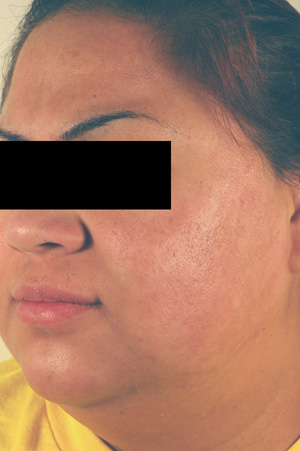
We have found that non-ablative laser treatments (those that have no downtime and are non-invasive) are not the best choice for these types of acne scars. Instead, we believe that laser resurfacing is a good option for depressed acne scars.
There are many newer technologies for laser resurfacing and the best treatment option is determined based on the the degree of your scarring and your skin type. In some situations where scarring is profound, punch excision may be a better option.
This is a technique wherein the physician excises (cuts out) the damaged scar area and sutures it closed to form a clean, discrete scar.
Evaluating these are options for improvement is a good first step in treating depressed acne scars.
You can find laser hair removal in almost every city in America. Dermatologists, plastic surgeons, OB/Gyns and family practice offices offer it? But who’s qualified to do laser hair removal and how can you ensure you’re getting an effective treatment?
You may not be surprised to learn that price isn’t the most important factor! Understanding the available devices and which one is right for you is really the first thing you need to consider when choosing your laser hair removal provider.
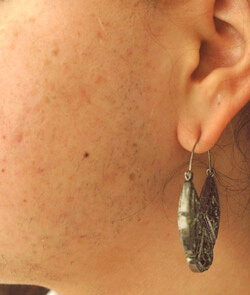
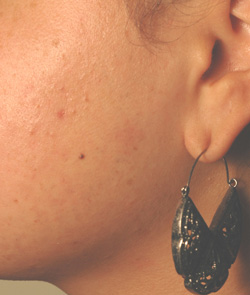
Laser Hair Removal before and after pictures
Let us explain a bit more. First, you need to know what your skin type (color) is. There are six different skin types: type I to type VI. We’ve listed them along with a description below for you:
Now that you understand your skin type, let’s talk about the different laser hair removal devices. Each of these is specific for a certain range of skin types. This should help you decide which class IV medical laser is the right choice for laser hair removal. There are three, different devices currently available:
The diode laser is the most common laser hair removal device used today. The Lumenis LightSheer is a brand of diode laser considered the “gold standard” for laser hair removal among medical laser professionals. It is ideal for skin types I through IV. And although the manufacturer advises that it may be used on higher skin types (with certain models), our experience has not shown this to be true. We would strongly caution those with a skin type V or VI against having laser hair removal with this device.
The Alexandrite laser is a less commonly used device, but still very effective for laser hair removal in skin types I through III. We generally would not recommend its use in anyone over a skin type III due to the risk of hyperpigmentation or darkening of the skin and blistering. There are several brands of Alexandrite lasers, but the Cynosure Apogee is the most widely used device in this category.
Lastly, the Nd:Yag laser is the type of device that is most commonly used laser hair removal device for darker skin types (type V and VI). What makes this device safe for dark skin? Remember that laser hair removal works by damaging the follicle with heat (or light) energy. All the lasers listed above target melanin which is the pigment that lines the hair follicle and gives the hair color. Since people with black skin have a lot of melanin in their skin and hair, special laser technology must be used to properly target the melanin in the follicle while avoiding it in the skin. At Celibre, we use a device called the Sciton Profile.
The Sciton Profile is a long-pulsed Nd:Yag laser that uses a greater penetrating wavelength of light that can get to the deeper melanin in the follicle and bypass the melanin closer to the skin’s surface that gives it color. This device is extremely safe for all dark skin types and works very well for laser hair removal in black skin.
Before you consider laser hair removal, take a moment to familiarize yourself with the most common types of lasers. This will help ensure a better outcome with more permanent hair removal for you.
Generally speaking, yes, laser hair removal is uncomfortable. But if that’s what’s keeping you from considering having treatment, then perhaps you should reconsider? Everyone’s perception of pain is different, and we feel like we have identified a few factors that are correlated with an increased amount of pain with laser hair removal. If you don’t fall into one of these groups, maybe it is something that you should think about doing! If you are in one of them, we suggest you try at least a single treatment. Often patients will tell us that the pain of laser hair removal was more a figment of their imagination than a reality after they’ve gone through a treatment or two.
Through our unofficial research, we’ve found the following factors generally point to increased pain with laser hair removal: thick, dark or coarse hair; young age; and male gender. Let’s go into each of these briefly:
Thick, dark, coarse hair is a “target rich” environment for the laser. These follicles are larger and they contain more melanin or pigment, which is what the laser’s energy is drawn to and absorbed by. So naturally, people with this type of hair will feel the laser more. But on the flip side, that sensation tells you that the laser is working! This type of hair responds the best to laser hair removal.
Why the pain? Because the follicle must heat up to the point where it becomes structurally damaged and can no longer grow hair. The larger the follicle and the more “target”, the more heat absorption which produces the sensation or pain, but the better the results too!
The good news is that thick, dark hair disappears quickly, so pain typically diminishes with each subsequent laser hair removal treatment.
Younger patients tend to tell us that laser hair removal is more painful. Why? We aren’t totally sure, but maybe it has something to do with not having experienced much pain previously in life (those reading who are older can appreciate this). If you’ve gone through childbirth, a surgery or injury, then you have some experience with pain. Younger folks maybe just haven’t gotten in on all the fun yet! We also wonder if older patients are more committed to getting rid of their unwanted hair. They’ve shaved, waxed, tweezed and plucked to the point where they don’t care how much it hurts; they just never want to have to groom themselves again!
Men seem to tolerate the discomfort of laser hair removal less than women. We again can only speculate as to why, but possibly it’s because they tend to have thicker hair than women, so perhaps they really do feel it more? Or perhaps the societal pressure on women not to be hairy is so much greater for a woman than a man, that again, women don’t care how much it hurts—they just want the hair gone once and for all!
Remember, not everyone struggles with discomfort during laser hair removal. Pain is a highly individualized sensation, so you really don’t know how it will feel to you until you try it! At Celibre, we treat everyone with the same respect; and we take all measures we can to ensure that you are comfortable and can tolerate your laser hair removal procedure. We use topical numbing creams, ice packs and cold air to help ease your discomfort and get you through the procedure.
As the leader in laser hair removal in Southern California since 2004, we will tell you that during that time only a few patients have opted out of having laser hair removal with us because of pain. We encourage you to give it a try and see how it goes! We know you won’t be disappointed with your results!

* View Some of our Laser Hair Removal Before and After Pictures
When it comes down to it, we know that you have many choices when it comes to laser practices. And we also know that it’s the knowledge, skill and expertise of the laser practitioners and the breadth of technology that sets one practice apart from another. That’s why we’ve invested an enormous amount of time, energy and financial resources in finding the very best devices and placed them in the most capable hands to provide you with an array of treatment options that not only give you superior results, but that fit your lifestyle and budget too.
Patients like you want to know what we consider to be the top three lasers for resurfacing. Here’s our list and why we like these devices:
The erbium MicroLaser Peel: Although this device isn’t as powerful as the CO2 laser, it still can generate some impressive results. We use this device because in our hands, a series of three of these treatments can yield similar results to a single fractionated treatment. The benefits also include more predictable and tolerable downtimes (i.e. fewer complications) which we’ve found our patients need given their busy lifestyles.
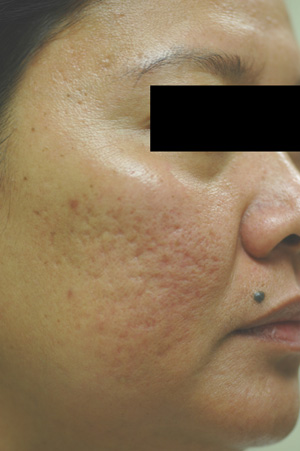

Erbium Laser Resurfacing Before and After Photos
Road rash is a slang or laymen’s term for a condition better known in the medical field as a traumatic tattoo. If you’ve ever had an accident—bike, car or motorcycle—or know someone who has, then you may be familiar with it. If a patient’s skin becomes scraped and filled with gravel, sand, pavement or asphalt during a traumatic accident, a “staining” effect can occur. The healed skin or “scar” that’s left behind usually has a blackish or bluish discoloration.
Many people aren’t aware that tattoo removal lasers are great tools for the treatment of road rash and should be used early in the recovery phase. These devices are safe to use on every skin type (color), so anyone who has suffered a road rash injury may have treatment. Laser treatments usually need to be done in a series, but the results and improvement we’ve seen with them is dramatic.
Older road rash injuries can be treated too, but may not respond as well to the laser. If you or someone you know has a road rash scar, there is help. We would love to opportunity to evaluate your injury and tell you more about the success we’ve had treating this difficult condition.
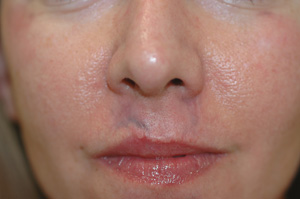
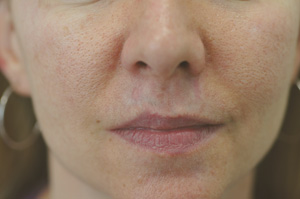
Scar Removal Before and After Pictures
If you’re considering laser tattoo removal to get rid of an unwanted tattoo, you might want to know what lasers work well. Laser tattoo removal can be a bit of a complicated thing; no doubt you’ve come across a lot of information and are a bit confused about what laser might be best for your tattoo.
We want to discuss with you the top three lasers that are used for laser tattoo removal. The first part of this article discusses the type of laser technology. These names are generic for the type of laser (not brand). The second list includes will name brands of each type (think Kleenex, Puffs, etc.). Putting these two lists together will help you as you shop around and research the best laser practice for your tattoo.
First, here are the generic laser types. This lasers may have different brand names, but that they all incorporate one (or more), specific wavelength(s) of light to remove specific colors of tattoo ink:
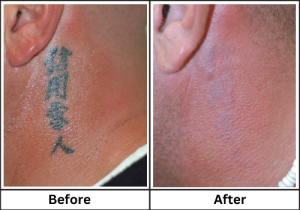
Now, onto the specific brands of these lasers:
So, remember when considering laser tattoo removal that both the type and brand of lasers matter in determining the result of your treatment.
Have you ever seen a keloid (bumpy, raised) scar and wondered why someone healed that way? Maybe you have one or more keloids and feel embarrassed or upset by the way they look. Keloid scars are easily recognizable, and the truth is, no one really knows exactly why they occur.
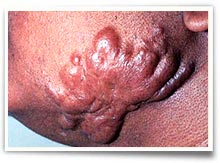
Keloid scars are very dense, raised and firm. The scar tissue of a keloid is very fibrous. Keloid scars differ from other types of raised, firm scars because they extend beyond the boundaries of the initial injury. They come in various shapes, colors and sizes. Commonly, they’re pink, red or brown. People with darker skin colors (especially Asians and African Americans) tend to develop keloids more frequently, but they can happen to anyone. They can form after a traumatic injury, a surgery, a piercing, and sometimes spontaneously.
If you have a keloid and have been wondering how you can make it look better, we have had success with steroid injections. If you’ve got a keloid scar and want to talk about having it removed, give us a call today.
Are you an adult suffering with acne? In addition to having small pimples, is your skin red, flaky, and irritated? If so, then you may have a condition known as acne rosacea.
Acne rosacea is a combination of two conditions: Rosacea, which causes facial irritation and redness due to excessive blood flow, and acne which causes the formation of red and yellow pimples. It’s common for the combination to occur in the nose, central forehead and cheeks.
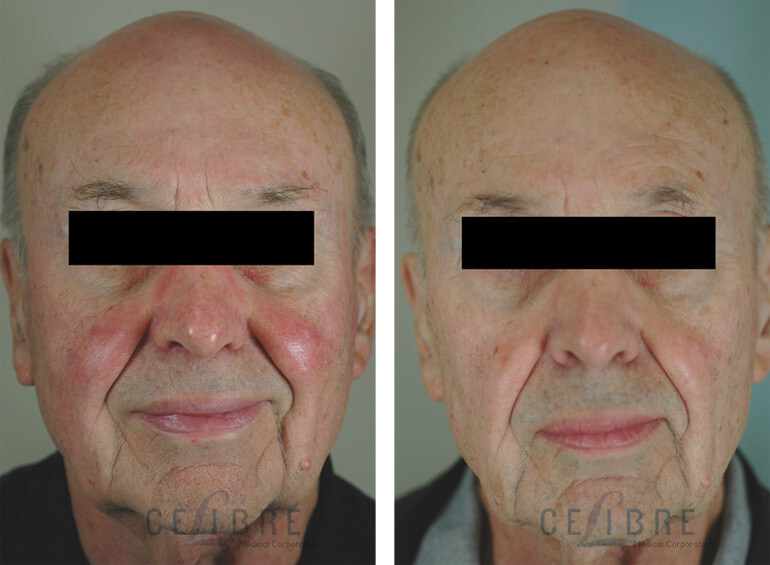
Acne rosacea typically affects lighter-skinned men and women who usually complain of having a long history of “sensitive” skin. We’d bet that many of the treatments that you’ve been prescribed have aggravated and irritated your skin. This story is common in those like you who are fighting acne rosacea.
To answer the title question of this page, there is no single theory that explains your condition. Several different ones exist and many researchers suspect that it is a combination of genetic, environmental and even emotional factors that contribute to acne rosacea.
Remember that acne and Rosacea are two, distinct and separate conditions. In the case of acne rosacea, they coexist! When you have acne rosacea, the two tend to “feed off” of one another as the increased vascularity that causes your red skin also drives the formation of more of the pimple-like acne blemishes. As you might guess, both conditions need to be addressed separately. You may see little to no improvement unless both are treated simultaneously.
At Celibre Medical, we’ve used a combination of both the Aramis and pulsed dye lasers to help our acne rosacea patients. We’ve also seen patients improve after treatment with photodynamic therapy. Of course, we can help you pick out the proper skin care products to help control your acne rosacea and keep your skin looking smooth and clear. These products are geared to be extra gentle and calming for your skin.
We understand that no one likes acne, especially a busy adult. Call today to find out how we can help you get the clear skin you want with proven treatments!
When you choose Celibre Medical for your laser dermatology needs, you are choosing one of the most experienced laser practices in the Los Angeles and Torrance areas. Our laser experience dates back to the mid 1990’s when CO2 resurfacing was one of the few lasers on the market. While we are proud of our history, we’re even more proud of our results. Take a look by viewing our extensive gallery of before and after photos.
Our patients often wonder why we are so diligent about our photography. It’s because we believe that there is no better way to document, evaluate and share (with your permission) the results of our laser treatment programs than with good before and after photographs. Our protocols include multiple photos throughout the treatment process including before your first treatment, during and after we’ve completed the program.

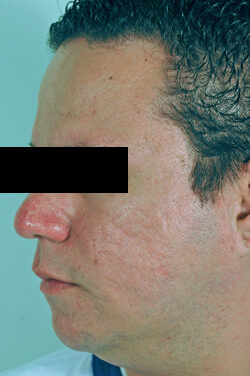
Photography provides objective evidence of what the laser treatments or injections are doing for your skin. Sometimes, your results may be incremental, and you may need photographs to show that you are making progress with each treatment. Photos can also help your practitioner assess your progress. If you aren’t making the expected progress, photographs can help us adjust your program to get you back on track and where you want to be. Lastly, should you and your laser practitioner ever have a concern about the results your treatments; photographs provide an objective method to evaluate the concerns.
If you’ve visited a laser dermatology practice that doesn’t have any before and after photos of their own patients, then you should question this fact. Often, practices simply use photos supplied by the laser manufacturer. These often look good, but aren’t always representative of the kind of results most patients achieve. We want you to see OUR OWN patients and the fantastic results we have achieved with them. We believe that setting realistic expectations for your treatment at the beginning is key to your success and satisfaction with your treatment program.
We believe our before and after photos speak for themselves and offer you a very accurate, real-world representation of our work. We are just as proud of our results as our patients are, and believe that there’s no better way to share these results with you than with before and after photos. Feel free to come by and see them for yourself.
Fractional laser resurfacing is sort of the “it” procedure right now. Everything from scars to dark spots to lines and wrinkles can just be resurfaced away with a laser. Well—this isn’t exactly true. In fact, it’s not really true at all! While laser resurfacing is certainly a popular procedure right now, not all laser resurfacing treatments are the same. And not all practices providing laser resurfacing treatments can get the same results—even if they are using the same laser!
We regularly get phone calls from unhappy patients who feel that they didn’t get the results they were looking for from a Fraxel or other fractional laser resurfacing procedure. While it is understandable that they are upset, we want to help you avoid the same situation. Few consumers realize that it’s not the laser used that determines the outcome. Many of the fractional lasers available are very similar, and it’s how the laser is used and how the patient is prepared that determines the outcome.
Here is the reason why not all fractional laser resurfacing procedures are the same. It comes down to the depth of treatment, whether or not coagulation is used (deep heating of the skin), and % of the skin resurfaced. Each of these parameters is 100% customizable by the practitioner. This means that if your practitioner doesn’t understand how to manipulate them in a way that is most beneficial for your condition (scars, wrinkles, etc.), then you won’t see the results that you’d hoped for.
Out the unhappy patients who contact us, about 90% of them simply didn’t get a treatment that was deep enough. Here’s how we know:
At Celibre Medical, we will perform ablative fractional resurfacing down to 1000 microns (or 1 millimeter). Most other practices limit this number to 200-300 microns. While we are more aggressive and our patients have more bleeding, we find that when they’re educated and prepared for it, they handle it very well. And we also ensure that they understand our rationale for choosing a deeper treatment approach. We want them to see their skin problems improve greatly after just a single treatment!
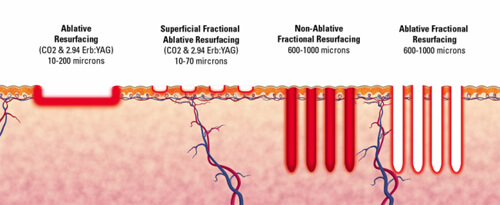
We have also included some photos of what a typical 7-day recovery process looks like at our practice. You can see that immediately after the procedure there is some bleeding. While it may not look good, we know that this sign means that we’ve provided a deep resurfacing treatment that will look good once it’s healed!
We don’t believe in providing just a standard laser resurfacing. We know this means we must spend more time talking with you, carefully examining your skin, educating you and preparing you for all aspects of your treatment and recovery! Yes, this takes time and is more complicated, but it ensures that we will provide the best outcome for you that we possibly can. And happy patients are the reason we do what we do.
No, you’re not allergic to laser tattoo removal. While that is often the first thought of someone who gets hives after tattoo removal, we promise that’s not the case. We know that some patients develop red, itchy, raised and swollen looking skin immediately after laser treatment of their tattoo. Why? No one is quite sure, but it is a frequently reported adverse reaction to treatment.
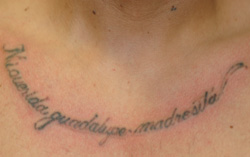
Here’s what we think may be going on. If you’ve read about laser tattoo removal, you understand the laser works to break up the tattoo ink particles into much smaller pieces that can be removed and cleared by your body’s immune system. It’s been proposed that your immune system has a bit of a panic attack over the sudden, large amount of these ink particles that are created all at once during the treatment.
This immediate influx of foreign material in the skin triggers the redness, swelling and firmness that you see and feel. It also creates a sensation of mild pain and itching in the treated area. And while all of this is temporary and lasts only minutes to hours after treatment, we know that it can be uncomfortable.
There are ways to help limit this reaction and at best, avoid it all together. First, take some Benadryl about an hour before your laser treatment. This helps stabilize some of the immune cells in the skin that release the chemical signals responsible for the “hive-like” reaction. If you don’t have Benadryl, any antihistamine medication will help. If this works, remember to use this medication before every treatment.
Second, apply a hydrocortisone cream to the affected area. This steroid medicine also helps to calm down the immune cells in the skin. Again, this method only works when you apply it directly after treatment.
Lastly, ask your laser practitioner if you can use cold air or an ice pack immediately following treatment. The cold constricts your skin’s blood vessels which slows down your body’s blood flow and hence, the number of immune cells that can migrate to the treated area. And a cooling sensation can be a welcome thing after laser tattoo removal—with or without a hive-like reaction! It just feels good!
If you’ve tried these things and continue to have problems, sometimes it’s necessary to divide your laser tattoo treatment into separate sessions (usually two) to help lessen your skin’s reaction to the laser. While this takes more time and is inconvenient, it is an option that works for some as a last resort.
Hive-like reactions can happen after laser tattoo removal. Make sure your laser practitioner is aware if you’re having problems so he or she can take steps to help you correct it!

